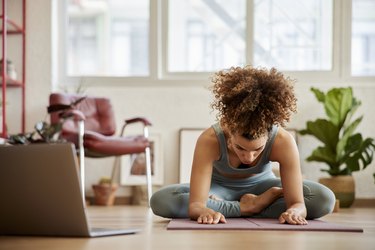
Your abs may be the first muscles that come to mind when you think "core workout." But don't forget your lower back — as Harvard Health Publishing notes, lower back workouts are an important part of any core training program.
Related Reading
Video of the Day
Lower Back Exercises at Home
The problem with doing lower back exercises at home, of course, is that you don't have access to the sort of equipment you'll find for lower back exercises in the gym. But here's some good news: You don't need any of that equipment to stretch and strengthen your lower back.
Here are three great do-anywhere exercises to strengthen and stretch your lower back.
1. Bird Dog
As demonstrated at the American Council on Exercise, the bird dog exercise is one of the "big three" exercises for maintaining lower back health, recommended by Stuart McGill, PhD, professor emeritus at the University of Waterloo and a noted researcher on lower-back rehabilitation.
- Get on your hands and knees with your hands directly in line with your shoulder and knees in line with your hips.
- Look down at the floor and brace your core (tucking your tailbone just slightly) to create a straight line from the tip of your head to your tailbone.
- On an exhale, reach your left arm straight out in front of you until your upper arm is in line with your ear.
- Simultaneously reach your right leg straight behind you, fully extending your knee.
- Pause here for a moment.
- Reverse the motion and return to the starting position.
- Switch sides, reaching your right arm forward and raising your left leg back.
- Pause and then go back to the starting position.
Tip
Pay close attention to your hips during this exercise. They should stay level — with no tipping to either side — throughout the motion.
2. Side Bridge
This exercise is recommended by both McGill and Makeba Edwards, CPT, an expert with the American Council on Exercise (ACE). Side bridges (or planks) might not be the first thing you think of when lower back training at home comes to mind, but you'll be happy to learn that they work the lateral muscles of your core, according to ACE — an important component of strengthening and stabilizing your lower back.
- Position yourself on left your side, left elbow bent and left forearm resting on the floor. Your elbow should be directly below your shoulder, and your shoulders, hips and knees should all be stacked vertically.
- Rest your bent knees on the ground or, for more of a challenge, straighten your legs and balance on the side of your lower foot.
- Lift your left hip off the ground and into a straight line with the rest of your body, keeping your left forearm/elbow and knees (or feet) on the floor.
- Repeat on right side.
3. Back Extension
As long as you don't have any health issues that prevent you from doing a back extension (think: arching your back) you can do this exercise, which is recommended by Princeton University's Athletic Department.
- Lie face-down on an exercise or yoga mat, legs straight and arms by your sides.
- Lift your head and chest slightly off the mat and squeeze your shoulder blades together. At the same time, squeeze your glutes to lift your feet off the ground a few inches.
- Hold this position for a few seconds, then return to the starting position.
- Repeat.
Tip
If your low back is uncomfortable, you might need to work more than just your back muscles. As noted in a June 2016 issue of the journal Healthcare, a general exercise program that combines aerobic fitness with muscular strength and flexibility — including developing the other muscles of your core — can be very helpful for reducing stiffness and nonspecific chronic low back pain.
- Healthcare: "A Systematic Review of the Effects of Exercise and Physical Activity on Non-Specific Chronic Low Back Pain"
- Harvard Health Publishing: "The Real-World Benefits of Strengthening Your Core"
- American Council on Exercise: "Low Back Exercises: Stuart McGill's Big Three"
- American Council on Exercise: "5 Exercises to Add to Your Lower Back Exercise Program"
- Princeton University: "Lumbar/Core Strength and Stability Exercises"